Blank L., Tarquin A. Engineering Economy (McGraw-Hill Series in Industrial Engineering and Management)
Подождите немного. Документ загружается.

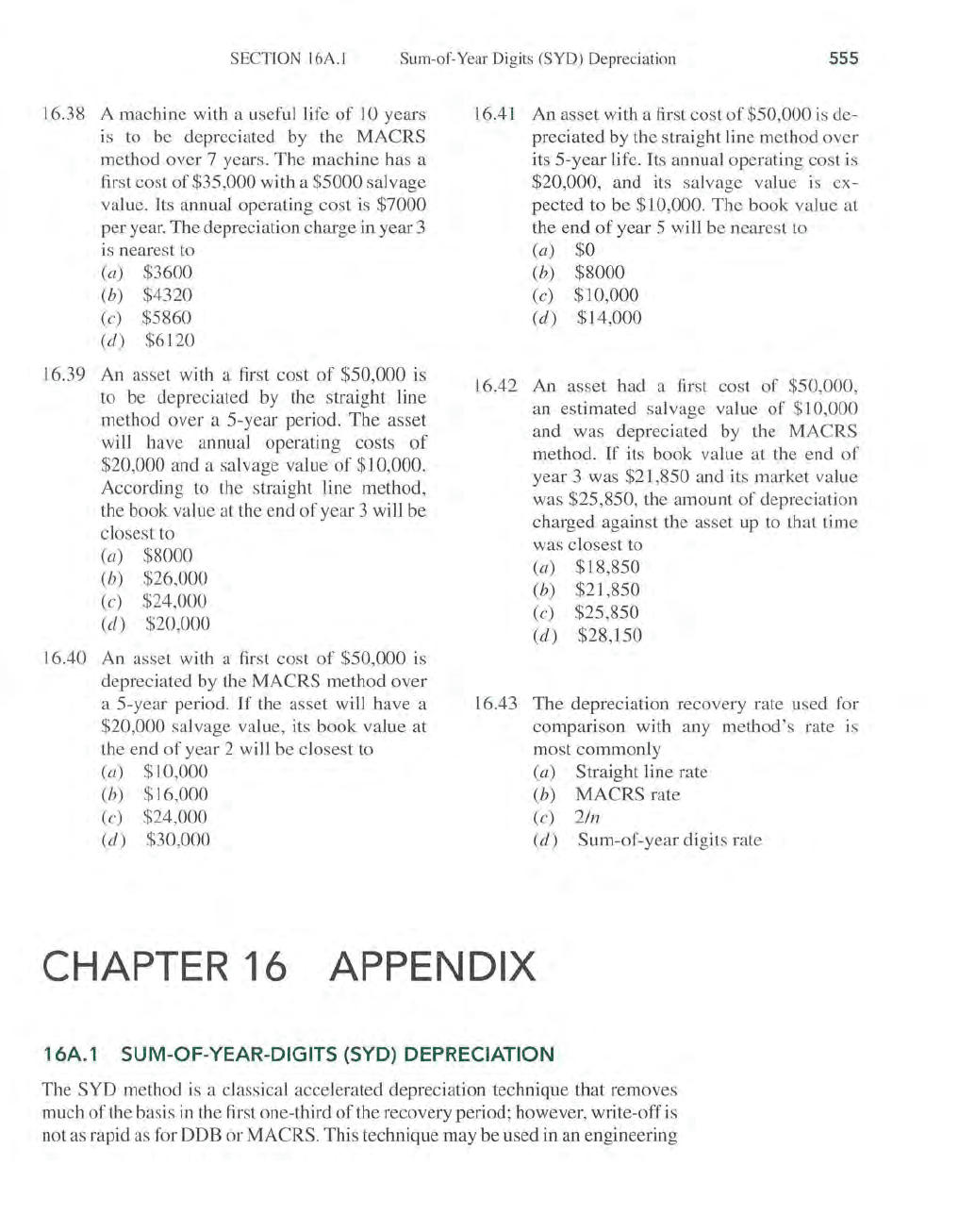
SECTION 16A.1 Sum-of-Year Digits (SYD) Depreciation
555
16.38 A machine with a useful life
of
10 years
is
to be depreciated
by
the MACRS
method over 7 years. The machine has a
first cost
of
$35,000 with a $5000 salvage
value. Its annual operating cost is
$7000
per year. The depreciation charge in year 3
is nearest to
Ca)
$3600
(b)
$4320
Cc) $5860
Cd)
$6120
16
.39
An
asset with a first cost
of
$50,000 is
to be depreciated
by
the straight line
method over a 5-year period. The asset
will have annual operating costs
of
$20,000 and a salvage value
of
$10,000.
According to the straight line method,
the book val ue at the end
of
year 3 will be
closest to
(a) $8000
Cb)
$26,000
(c) $24,000
Cd)
$20,000
16.40
An
asset with a first cost
of
$50,000 is
depreciated by the MACRS method over
a 5-year period.
If
the asset will have a
$20,000 salvage value, its book value at
the end
of
year 2 will be closest to
(a) $10,000
Cb)
$16,000
(c) $24,000
(d)
$30,000
16.41 An asset with a first cost
of
$50,000
is
de-
preciated by the straight line method over
its 5-year life. Its annual operating cost
is
$20,000, and its salvage value
is
ex-
pected to be
$10,000. The book value at
the end
of
year 5 will be nearest to
Ca)
$0
(b) $8000
(c) $10,000
Cd)
$14,000
16.42 An asset had a first cost
of
$50,000,
an estimated salvage value
of
$10,000
and was depreciated by the MACRS
method.
If
its book value at the end
of
year 3 was $21,850 and its market value
was $25,850, the amount
of
depreciation
charged against the asset up to that time
was closest
to
(a) $18,850
(b)
$21
,850
Cc)
$25,850
Cd)
$28,150
16.43 The depreciation recovery rate used for
comparison with any method's rate is
most commonly
(a) Straight line rate
(b) MACRS rate
(c)
21n
Cd)
Sum-of-year digits rate
CHAPTER 16
APPENDIX
16A.1 SUM-OF-YEAR-DIGITS (SYD) DEPRECIATION
The SYD method
is
a classical accelerated depreciation technique that removes
much
of
the basis
in
the first one-third
of
the recovery period; however, write-off is
not as rapid
as
for DDB or MACRS. This technique may be used
in
an engineering

556
Q-Solv
CHAPTER
16
Depreciation Methods
economy analysis in the depreciation
of
multiple-asset accounts (group and com-
posite depreciation).
The
mechanics
of
the
method
involve
the
sum
of
the
year's
digits from J
through the recovery period n.
The
depreciation charge for any given year is ob-
tained by mUltiplying the basis
of
the asset, less any salvage value, by the ratio
of
the
number
of
years remaining in the recovery period to the
sum
of
the
year's
digits
SUM.
D
= depreciable years
remaining
(b'
I
I)
aSls -
sa
vage
va ue
I
sum
of
year
digits
D = n
-t+
1
(B - S)
I SUM
where
SUM
is the sum
of
the digits 1
through
n.
SUM
=
)f,'i
= n(n + 1)
) = 1 2
the
book
value for any
year
t is calculated as
BV
= B -
t(n-t
/ 2 + 0.5) (B - S)
I SUM
[16A.l]
[16A.2]
[16A.3]
The
rate
of
depreciation decreases each
year
and equals the multiplier in
Equation
[16A.l].
d =
n-t+l
t SUM
[16A.4]
The
SYD
spreadsheet function displays
the
depreciation for the
year
t.
The
func-
tion format is
SYD(B,S,n,t)
Calculate the SYD depreciation charges for year 2 for electro-optics equipment with
B = $25,000, S = $4000, and an 8-year recovery period.
Solution
The sum
of
the year's digits
is
36, and the depreciation amount for the second year
by
Equation [16A.1] is
D2
= 3
7
6 (21,000) = $4083
The SYD function
is
SYD(25000,4000,8,2).
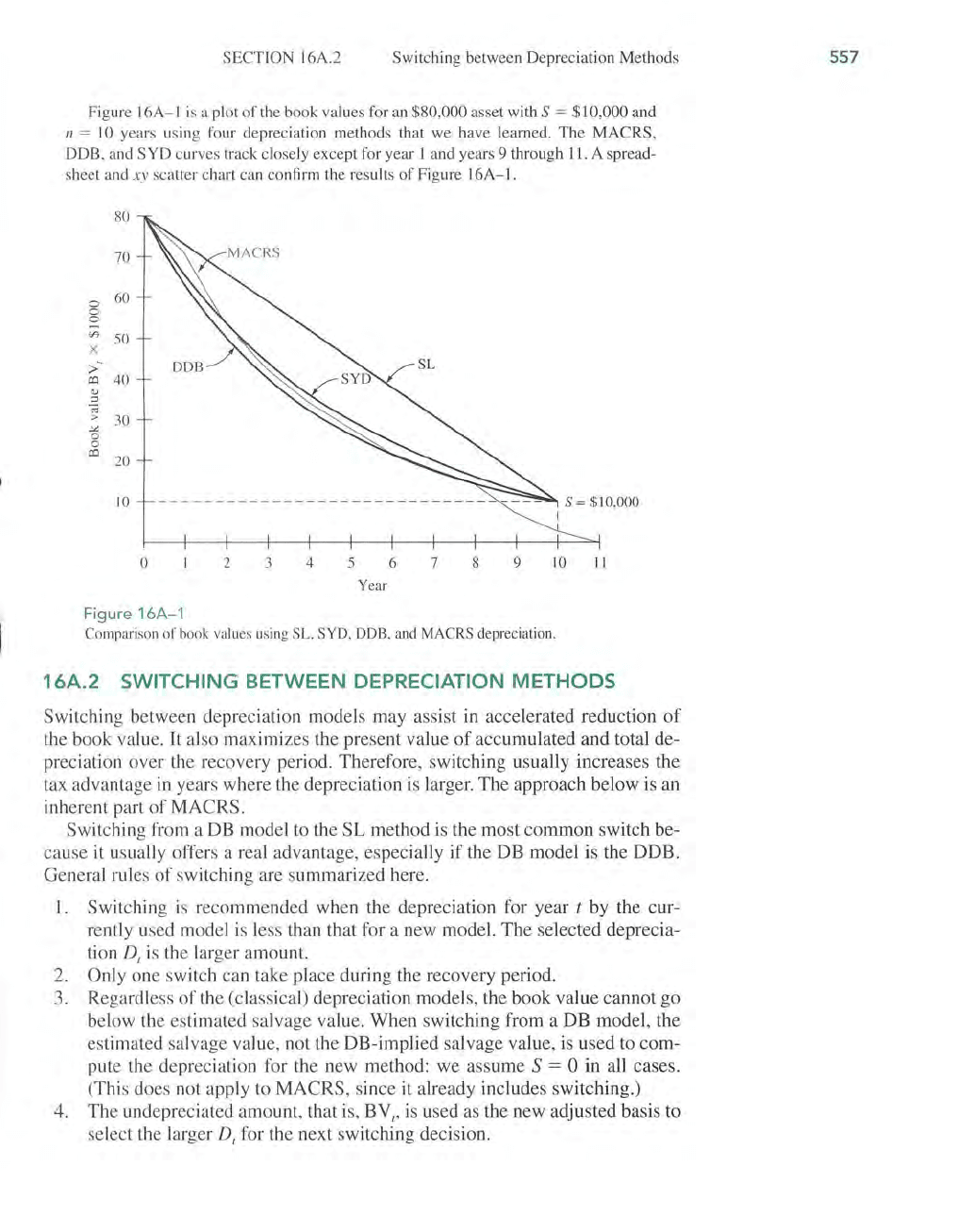
SECTION 16A.2 Switching between Depreciation Methods
Figure
16A
- 1 is a plot
of
the book values for an $80,000 asset with S = $10,000 and
n =
10
years using four depreciati
on
methods that we have learned. The MACRS,
DDB, and SYD curves track closely except for year
I and years 9 through
11.
A spread-
sheet and
xy scatter chart can confirm the results
of
Figure 16A-1.
0
0
S
fJ7
x
>-
I'l:1
"
"
OJ
>
"'"
0
0
I'l:1
80
70
60
50
40
30
20
10
DDB
SL
s= $10,000
I
0
2
3
4
5 6
7
8 9
10
11
Year
Figure
16A-1
COlllparison
of
book valu
es
using SL,
SYD,
DDB,
and
MACRS
depreciation.
16A.2 SWITCHING BETWEEN DEPRECIATION METHODS
Switching between depreciation models may assist in accelerated reduction
of
the book value.
It
also maximizes the present value
of
accumulated and total de-
preciation over the recovery period. Therefore, switching usually increases the
tax advantage
in
years where the depreciation is larger. The approach below is an
inherent part
of
MACRS.
Switching from a DB model to the SL method is the most common switch be-
cause it usually offers a real advantage, especialJy
jf
the DB model is the DDB.
General rules
of
switching are summarized here.
1.
Switching
is
recommended when the depreciation for year t by the cur-
rently used model
is
less than that for a new model.
The
selected deprecia-
tion
D,
is the larger amount.
2.
Only one switch can take place during the recovery period.
3.
Regardless
of
the (classical) depreciation models, the book value cannot go
below the estimated salvage value. When switching from a DB model, the
estimated salvage value, not the DB-implied salvage value, is used to com-
pute the depreciation for the new method: we assume S
= 0 in all cases.
(This does not apply to MACRS, since it already includes swit
ch
ing.)
4. The undepreciated amount, that is,
BY" is used as the new adjusted basis to
select the larger D, for the next switching decision.
557
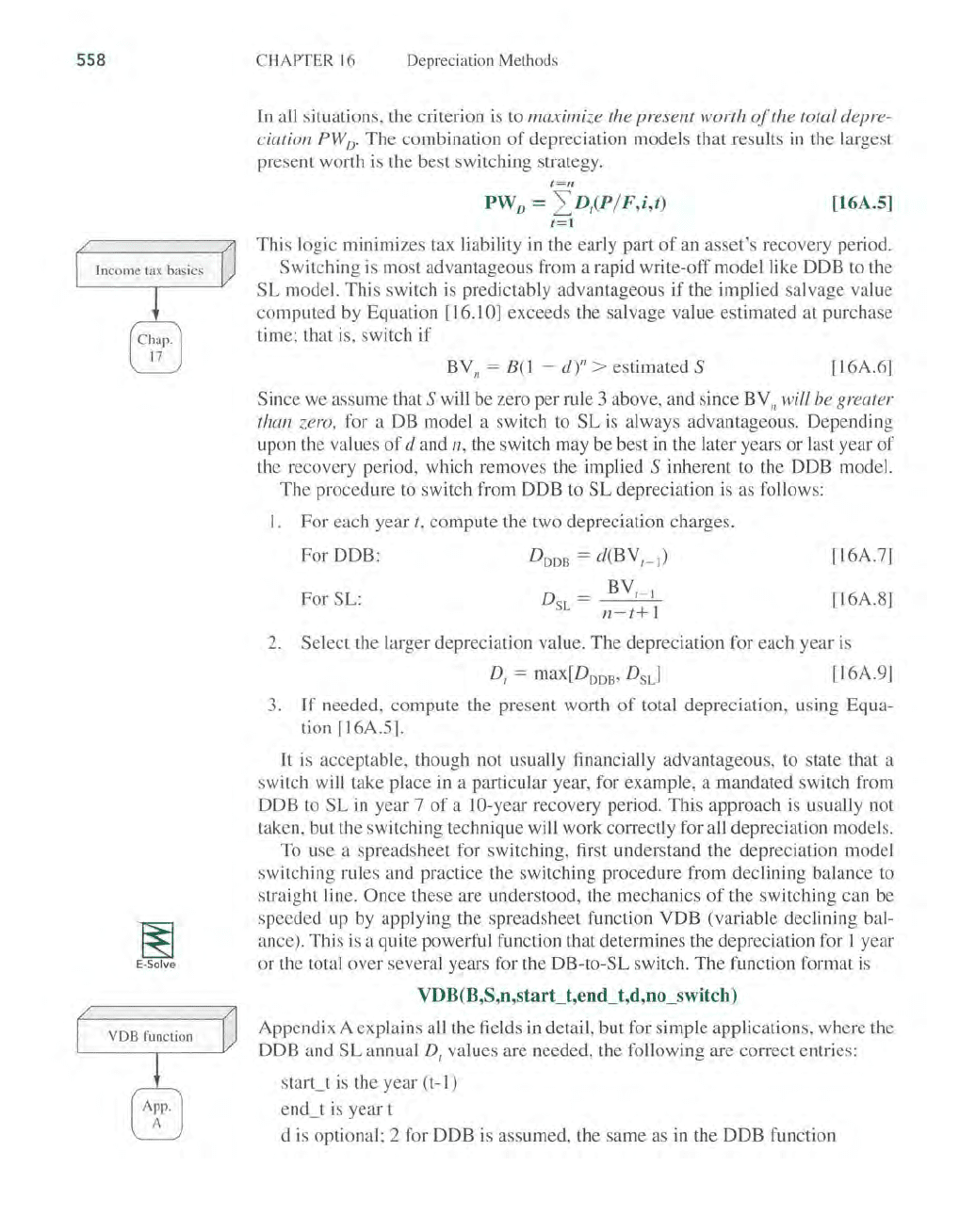
558
~
E-Solve
CHAPTER
16
Depreciation Methods
In all situations, the criterion is to maximize the present worth
of
the total depre-
ciation
PW
D
.
The combination
of
depreciation models that results
in
the largest
present worth is the best switching strategy.
t=1l
PW
D
= L
D(P
/F,i,t)
[16A.5]
/=1
This logic minimizes tax liability
in
the early part
of
an asset's recovery period.
Switching is most advantageous from a rapid write-off model like DDB to the
SL
mode
l.
This switch is predictably advantageous
if
the implied salvage value
computed by Equation [16.10] exceeds the salvage value estimated at purchase
time; that is, switch
if
B V
Il
= 8(1 - d)" > estimated S [ l6A.6]
Since we assume that
S will be zero per rule 3 above, and since
BV
Il
will be greater
than zero,
for a DB model a switch to
SL
is
always advantageous. Depending
upon the values
of
d and n, the switch may be best in the later years
or
last year
of
th
e recovery period, which removes the implied S inherent to the DDB model.
The
procedure to switch from DDB to
SL
depreciation is as follows:
I . For each year t, compute the two depreciation charges.
For
DDB
:
For SL:
DDDB
= d(BV
r
_
1
)
D = BV
r
-
1
SL
n-t+
1
[16A.
7]
[16A.8]
2.
Select the larger depreciation value.
The
depreciation
for
each year is
Dr
=
max[DDDB
' D
sd
[16A.9]
3.
[f
needed, compute the present worth
of
total depreciation, using Equa-
tion [16A.S].
It
is acceptable, though not usually financially advantageous, to state that a
switch
will take place in a particular year, for example, a mandated switch from
DDB to
SL
in
year 7
of
a IO-year recovery period. This approach is usually not
taken, but the switching technique will work correctly for all depreciation model
s.
To use a spreadsheet for switching, first understand the depreciation model
switching rules and practice the switching procedure from declining balance to
straight line.
Once these are understood, the mechanics
of
the switching can be
speeded up by applying the spreadsheet function VDB (variable declining bal-
ance). This
is
a quite powerful function that determines the depreciation for 1 year
or
the total over several years for the DB-to-
SL
switch. The function format is
VDB(B,S,n,starCt,end_t,d,no_switch)
Appendix A explains all the fields in detail, but for simple applications, where the
DDB and
SL
annual Dr values are needed, the following are correct entries:
start_t is the year
(t-l)
end_t is year t
d is optional; 2 for DDB is assumed, the
same
as
in
the
DDB
function

SECTION 16A.2
Switching between Depreciation Methods
no_switch is
an
optional logical value:
FALSE or
omitted-switch
to
SL occurs,
if
advantageous
TRUE-DDB
or DB model is applied with no switching
to
SL depreci-
ation considered.
Entering
TRUE for the no_switch option obviously causes the VDB function to
display the same depreciation amounts
as
the DDB function. This
is
discussed
in
Example 16A.2(d).
EXAMPLE 16A.2 f
The Outback Steakhouse main office has purchased a $100,000 online document imaging
system with
an
estimated useful life
of
8 years and a tax depreciation recovery period
of
5 years. Compare the present worth
of
total depreciation for (a) the SL method, (b) the
DDB method, and
(c) DDB-to-SL switching.
(d)
Perform the DDB-to-SL switch using a
computer and plot
dle book values. Use a rate
of
i
==
15% per year.
Solution
by
Hand
The MACRS method
is
not involved
in
this solution.
(a) Equation [16.1] determines the annual SL depreciation.
D
==
100,000 - 0
==
$20000
, 5 '
Since
D,
is
the same for all years, the P / A factor replaces P / F
to
compute PW
D'
PWD
= 20,000(P/A,15%,5) = 20,000(3.3522) = $67,044
(b) For DDB, d =
2/5
= 0.40. The results are shown in Table 16A-1. The value
PWD
= $69,915 exceeds the $67,044 for SL depreciation.
As
is predictable, the
accelerated depreciation
of
DDB increases
PW
o
'
.
(c) Use the DDB-to-SL switching procedure.
1.
The DDB values for
D,
in Table
16A-l
are repeated
in
Table
16A-2
for compar-
ison with the
DSL
values from Equation [16A.8]. The
DSL
values change each
year because
BV
H
is
different. Only
in
year 1
is
DSL
= $20,000, the same as
computed in part
(a). For illustration, compute
DSL
values for years 2 and
4.
For
t =
2,
BV I = $60,000
by
the DDB method and
D = 60,000 - ° =
$15000
SL
5-2+1
'
For
t = 4, BV
3
= $21,600
by
the DDB method and
D = 21,600 - 0 = $10 800
SL
5-4+1
'
2.
The column "Larger D/' indicates a switch in year 4 with
D4
=$10,800.
The
DSL
= $12,960
in
year 5 would apply only
if
the switch occurred in year
5.
Total depreciation with switching is $100,000 compared to the DDB amount
of
$92,224.
3.
With switching, PW D
==
$73,943, which is an increase over both the SL and
DDB models.
559
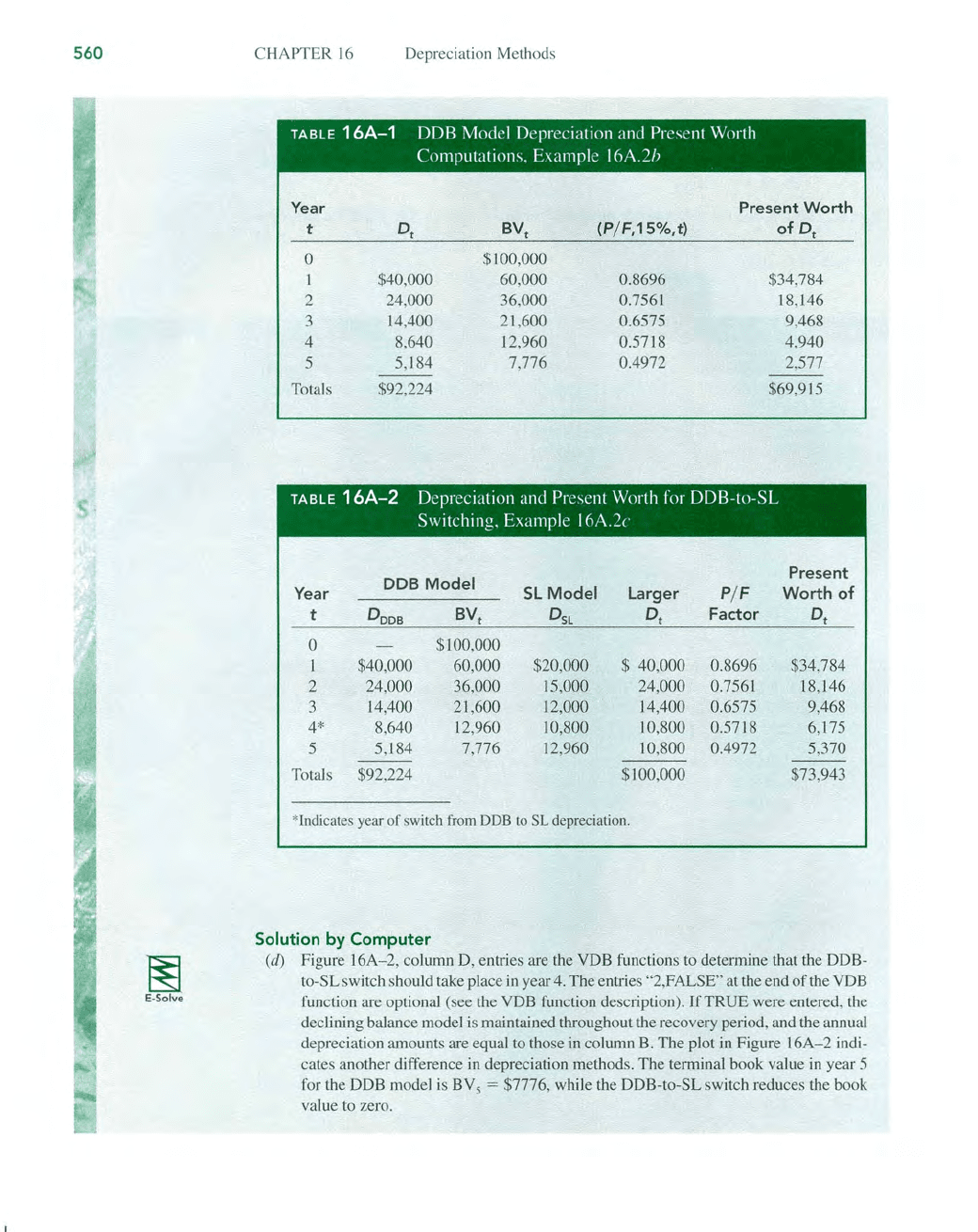
560
~
E-Solve
CHAPTER
16
Depreciation Methods
TABLE
16A-1
DDB
Model
Depreciation
and
Present Worth
Comp
utations.
Examp
le
l6A
.2h
Year
Present
Worth
t
°t
BV
t
(PjF,15%,t)
of
0t
0
$100,000
$40,000 60,000
0.8696 $34,784
2
24,000
36,000
0.7561 18,146
3
14,400
21,600
0.6575
9,468
4 8,640
12
,960 0.5718
4,940
5
5,184
7,776
0.4972
2,577
---
Totals $92,224 $69,915
T
ABLE
16A-2
Depreciation and Present Worth for
DDB-to-SL
Switch
ing.
Exa
mple l
6A
.2c
DDB
Model
Present
Year
SL
Model
Larger
Pj F
Worth
of
t
°DDB
BV
t
°SL
°t
Fact
or
°t
0
$100,000
1
$40,000 60,000 $20,000 $ 40,000 0.8696 $34,784
2
24,000 36,000
15,000
24,000 0.7561 18,146
3
l4
,400
21,600 12,000 14,400
0.6575 9,468
4*
8,640
12
,960
10
,800
10
,800 0.5718 6,175
5
5,184 7,776 12,960
10
,800 0.4972 5,370
Totals $92,224
$100,000
$73,943
*lndicates year
of
switch from DDB
to
SL depreciation.
Solution
by
Computer
(d) Figure 16A-2, column D, entries are the VDB functions to determine that the DDB-
to-SL switch should take place
in
year
4.
The entries "2,FALSE" at the end
of
the VDB
function are optional (see the VDB function description). If
TRUE were entered, the
declining balance model is maintained throughout the recovery period, and the annual
depreciation amounts are equal to those in column B. The plot in Figure
16A-2
indi-
cates another difference in depreciation methods. The terminal book value
in
year 5
for the DDB model is BY
5 = $7776, while the DDB-to-SL switch reduces the book
value to zero.
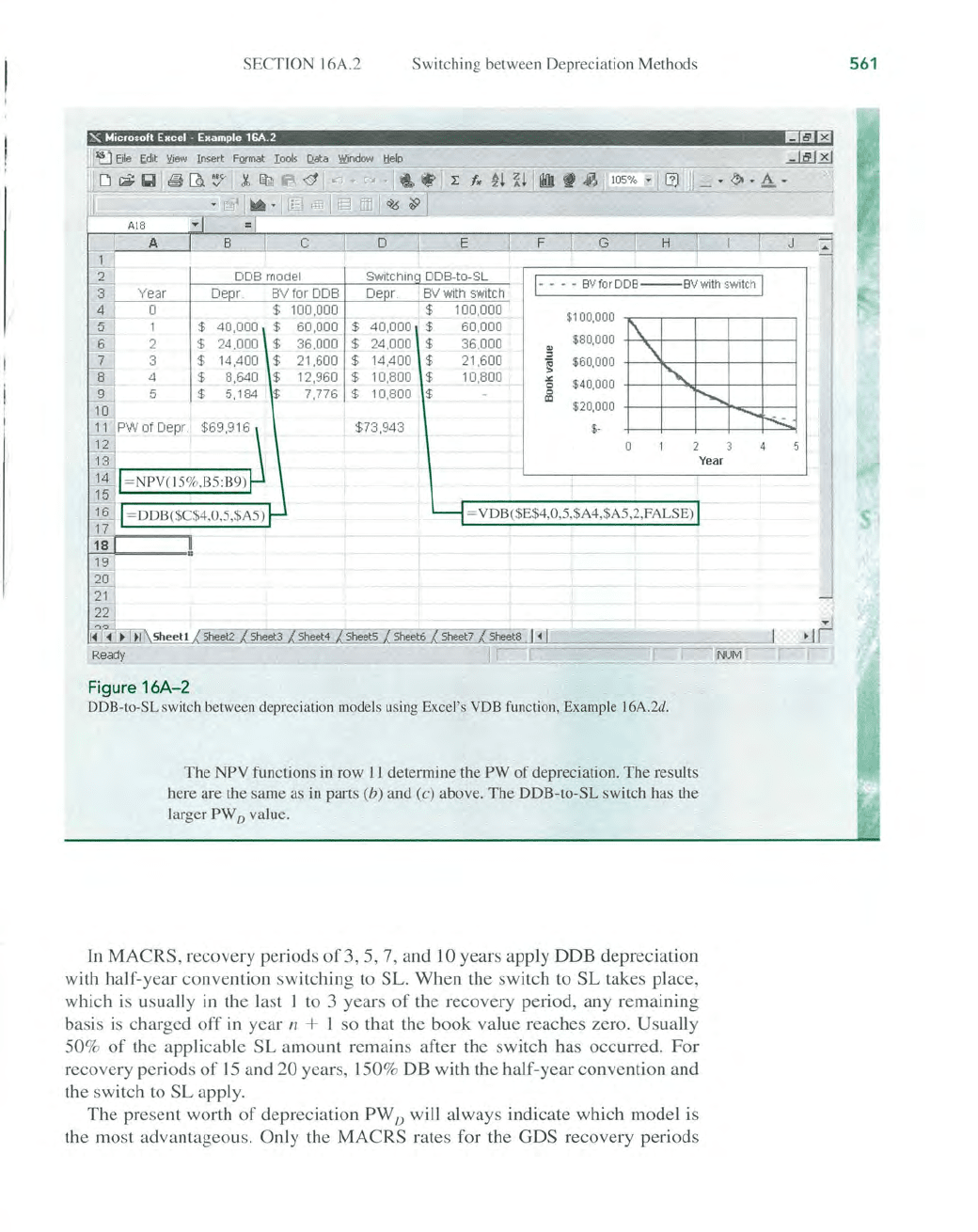
SECTION 16A.2 Switching be
tw
een Depreciation Methods
X
..
hcrosoft Excel - Example
16A
.2
1!!I~13
~iew
insert
FQ.rmat
Iools
Q.ata
~indow
t:!.elp
D
DB
model Swit
ch
in DDB-to-SL
I- - - -8V
fo
r
DD8--8
Vw
ith
swit
ch
1
Year
De r.
BVlor
DDB
De
r. BV with
swi
tch
4
0
$ 100,000 $ 100,000
$10
0,
000
5
1
$ 40,000
$
60,000
$ 40,000 $ 60,000
6
2 $
24,000 $ 36,000 $ 24,000 $ 36,000
'"
$80,000
7 3
$ 14,400 $ 21,600 $ 14,400 $ 21,600
~
$60,000
8
4
$ 8,640 $ 12,960 $ 10,800 $ 10,800
'"
$40,000 0
5 $ 5,184 $ 7,776 $ 10,800 $
0
Qj
$20
,0
00
$73,943
$-
Year
= VDB($E$4,O,5,
$A4,
$A5,
2,FALSE
)
Figure 16A- 2
DDB-to-SL
switch between depreciation
mode
ls using
Exce
l
's
VDB
function,
ExampleI6A.2d,
The NPY functions
in
row
11
determine the PW
of
depreciation. The results
here are the same
as
in
patts (b) and (c) above. The DDB-to-SL switch has the
larger
PW 0 value.
In
MACRS
, recovery periods
of3
, 5, 7, and 10 years apply
DDB
depreciation
with
half
-year convention switching to SL. When the switch to
SL
takes place,
which
is
usually
in
the last I to 3 years
of
the recovery period, any remaining
basis
is
charged
off
in
year n + I so that the
book
value reaches zero. Usually
50%
of
th
e applicable
SL
amount remains after the switch has occurred_
For
recovery periods
of
15
and
20
years, 150% DB with the half-year convention and
the switch to
SL
apply.
The
present worth
of
depreciation PWf) will always indicate which model is
the most advantageous. Only the
MACRS
rates for the GDS recovery periods
561
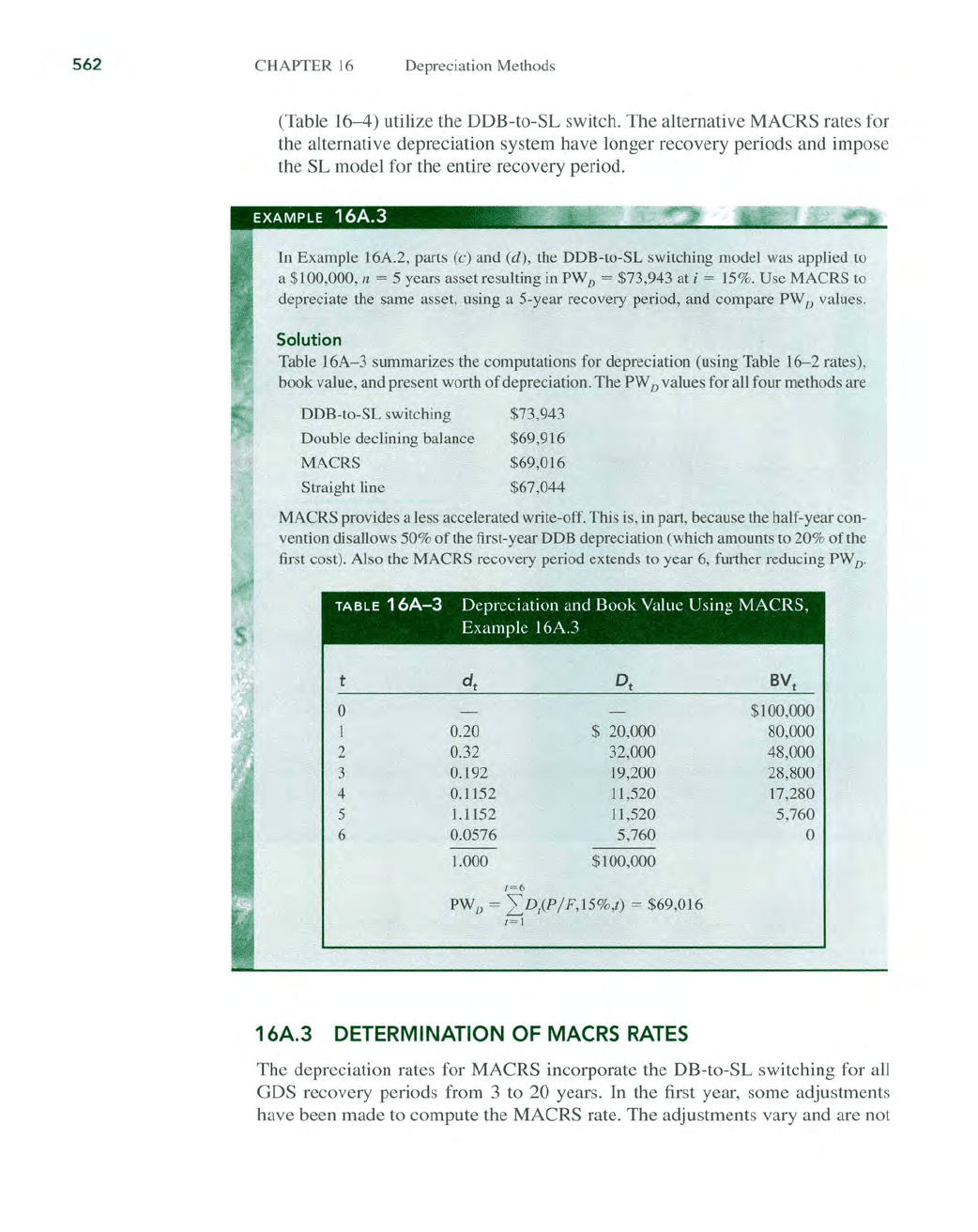
562
CHAPTER
16
Depreciation Methods
(Table
16-4)
utilize the
DDB-to
-
SL
switch.
The
alternative
MACRS
rates for
the alternative depreciation system have longer recovery periods and impose
the
SL
model for the entire recovery period.
In Example 16A.2, parts (c) and (d), the DDB-to-SL switching model was applied to
a
$100,000, n = 5 years asset resulting in
PW
D
= $73,943 at i =
15
%. Use MACRS to
depreciate the same asset, using a 5-year recovery period, and compare
PW D values.
Solution
Table 16A-3 summarizes the computations for depreciation (using Table 16--2 rates),
book value, and present worth
of
depreciation. The PW D values for all four methods are
DDB-to-SL switching
Double declining balance
MACRS
Straight line
$73,943
$69,916
$69,016
$67,044
MACRS provides a less accelerated write-off. This
is
,
in
part, because the half-year con-
vention disallows
50%
of
the first-year DDB depreciation (wbich amounts to 20%
of
the
first cost). Also the MACRS recovery period extends
to
year 6, further reducing PW
D'
TABLE
16A-3
Depreciation and Book Value Using
MACRS,
Example
16A.J
t d
t
D
t
BV
t
0
$100,000
1 0.20 $ 20,000 80,000
2
0.32 32,000 48,000
3
0.192 19,200 28,800
4 0.1152 11,520
l7
,280
5
1.1152 11,520
5,760
6
0.0576 5,760
0
l.000 $100,000
1= 6
PW
D
=
LV,(P/F,
15%,t) = $69,016
[= 1
16A.3 DETERMINATION OF MACRS
RATES
The
depreciation rates for
MACRS
incorporate the
DB
-to-SL switching for all
GDS
recovery periods from 3 to 20 years. In the first year, some adjustments
have been made to compute the
MACRS rate.
The
adjustments vary and are not

SECTION 16A.3 Determination
of
MACRS
Rates
usually
considered
in
detail
in
economic
analyses.
The
half-year
convention
is
always
imposed
,
and
any
remaining
book
value in
year
n.
is
removed
in
year
n.
+
I.
The
value
S = 0
is
assumed for all
MACRS
schedules.
Since
different
DB
depreciation rates apply for different n values, the follow-
ing
summary
may be used to
determine
D,
and BY, values.
The
symbols
DDB
and
DSL
are used to identify
DB
and
SL
depreciation, respectively.
For n = 3, 5,
7,
and
10 Use
DDB
depreciation with the
half-year
convention,
switching to
SL
depreciation in year t when
DSL
2':
DDB.
Use
the
switching
rules
of
Section 16A.2, and
add
one-half
year
when
computing
DSL
to
account
for the
half-year
convention.
The
yearly depreciation rates are
d =
{~
, 2
n
t = 1
[16A.IO]
t =
2,3,
.
..
Annual depreciation values for
each
year
t applied to the adjusted basis, allowing
for the half-year
convention,
are
[16A.ll]
D =
{±(~)B
SL
BY
,- I
n - t + 1.5
t=
[l6A.12]
t =
2,3
,
...
,n
After the switch to
SL
depreciation takes
place-usually
in the
last
1 to 3 years
of
the recovery
period-any
remaining
book
value
in
year
n
is
removed
in
year
n +
1.
For n =
15
and
20
Use
150% DB with the
half-year
convention
and the
switch to
SL
when
DSL
2':
DDB.
Until
SL
depreciation is
more
advantageous,
the
annual
DB
depreciation is
computed
using the
form
of
Equation
[l6A
.7]
where
{
0.75
d
=
n.
.,
1.50
t = I
[l6A.13]
t =
2,3,
...
n
563
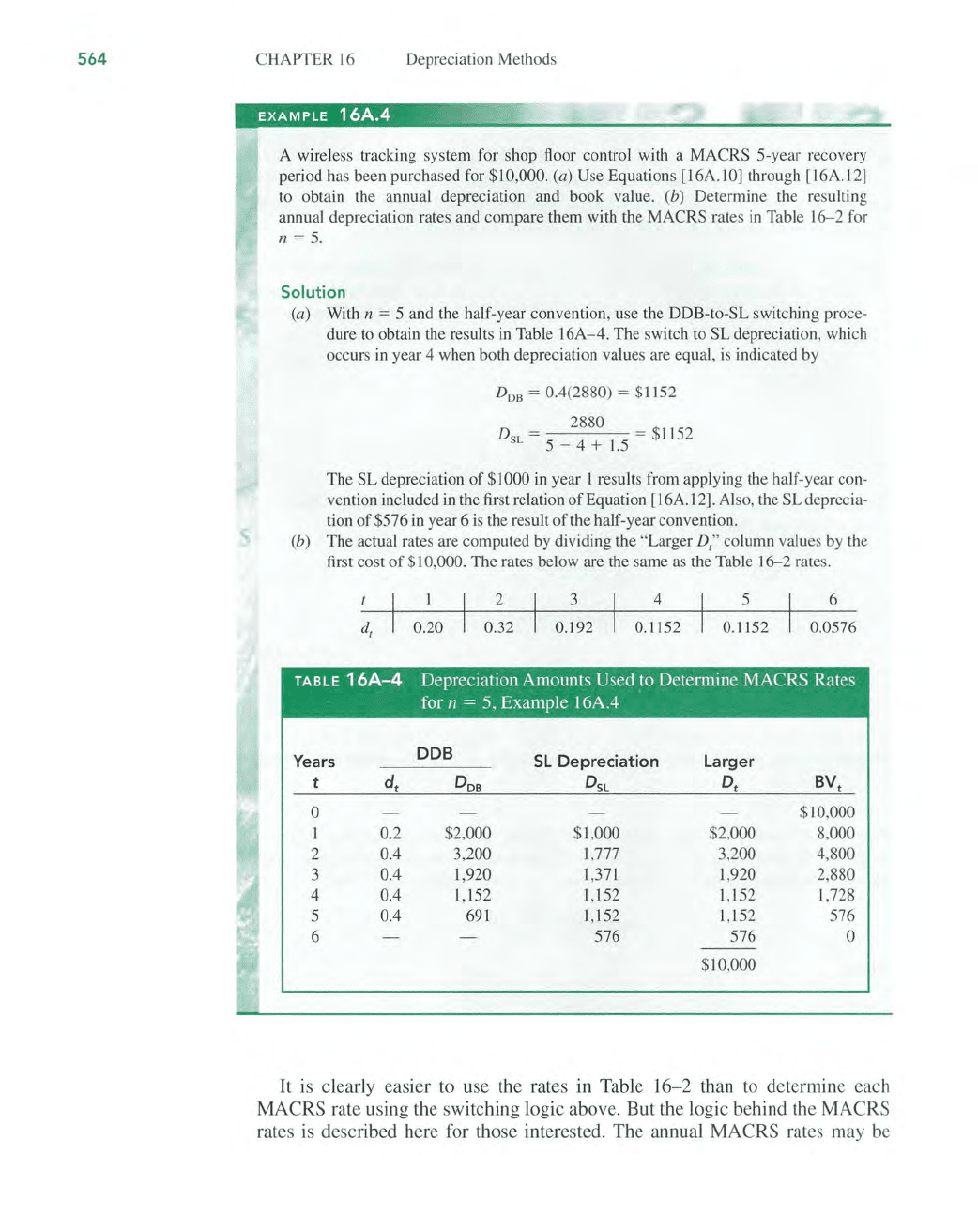
564
CHAPTER
16
Depreciation Methods
EXAMPLE
16A.4
,,;<
A wireless tracking system for shop floor control with a MACRS 5-year recovery
period has been purchased for $10,000. (a) Use Equations [16A. I 0] through [16A.
12]
to obtain the annual depreciation and book value. (b) Determine the resulting
annual depreciation rates and compare them with the MACRS rates
in
Table 16- 2 for
It
=
5.
Solution
(a) With n = 5 and the half-year convention, use the DDB-to-SL switching proce-
dure
to
obtain the results
in
Table
16A-4.
The
switch to
SL
depreciation, which
occurs
in
year 4 when both depreciation values are equal,
is
indicated by
Dos = 0.4(2880) = $1152
2880
DSL
= 5 _ 4 +
1.5
= $1152
The
SL
depreciation
of
$1000
in
year 1 results from applying the half-year con-
vention included in the first relation
of
Equation [16A.12]. Also, the SLdeprecia-
tion
of
$576
in
year 6 is the result
of
the half-year convention.
(b)
The
actual rates are computed by dividing the "Larger D
/'
column values by the
first cost
of
$10,000.
The
rates below are the same as the Table
16-2
rates.
2
3
4
5 6
d,
0.20 0.32 0.192 0.1152 0.1152 0.0576
TABLE
16A-4
Depreciation Amounts Used
~o
Determine MACRS Rates
for
11
= 5, Example 16A.4
Years
DDB
SL
Depreciation
Larger
t d
t
Dos
DSL
D
t
BV
t
0
$10,000
0.2
$2,000
$1
,000 $2,000 8,000
2 0.4 3,200
1,777
3,200 4,800
3
0.4 1,920
1,371
1,920 2,880
4 0.4
1,152 1,152 1,152 1,728
5
0.4 691
1,152 1,152 576
6
576 576
0
---
$10,000
It
is
clearly easier to use the rates
in
Table
16-2
than to determine each
MACRS
rate using the switching logic
above
.
But
the logic behind the
MACRS
rates is described here for those interested.
The
annual
MACRS
rates may be
